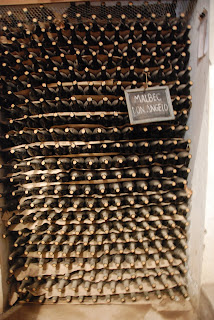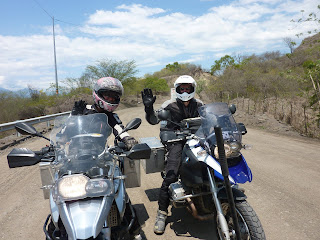Days 163-164
Welding complete only a few hours later than expected, and the new tyres pumped up as BMW hadn't seemed to have bothered, we set out for Valparaiso, Santiago's hip little sister 120km away on the coast. The highlight of our explorations around the very hilly town was looking around Neruda (famous Chilean poet)'s house – full of eccentric artefacts and designed to give fantastic views over the city and sea.
On arriving in Valparaiso we saw an oil warning light on Emily's bike which, on consulting the manual, meant “low oil pressure, stop riding immediately”. As we couldn't see anything wrong with the oil level and the light went off on it's own, there wasn't much to be done but to continue the next day to Mendoza, Argentina – famed for its wine and also somewhere with a BMW dealership that might have new sprockets for Emily's bike. However we had only rounded one corner when Emily declared there was something else wrong. Thinking back to the day before we realised BMW probably had pumped up the tyres after all – Emily had a puncture in her brand new front tyre and it was flat again! We pumped it up and continued on for a good few hours before the oil warning light came on again. We thought we might be losing oil pressure through a leak somewhere and this was confirmed by some oil residue around the filler and on Emily's boot, so the first time the light came on Ric cleaned all the grime out from the filler cap, and the second time he tightened all the bolts on the crank case. Each time the light stopped for a while, but it kept coming back on when the engine got hot. It's pretty annoying to take your fully working bike in for a service and leave with a puncture and a serious looking warning light and it was very tempting to turn back to Santiago and give them an earful. But we really needed to get to Mendoza to try to get the sprockets and we didn't have time to do both before heading south for Christmas. So onwards we went and managed to arrive in Mendoza pretty late, but with only a few miles riding with a flashing warning light.
Days 165-167
We turned up at the BMW dealership first thing in the morning and begged the very busy service department to help us out. They were happy to, but the bike was in a queue behind the ones already in the workshop.
The bike delays in Mendoza had their 
Back at BMW we found that the oil light was actually due to a broken cooling fan (hot runny oil holding less pressure), and this was fixed by 2pm on day 165. They hadn't had time to look at the tyre but we needed to head on and could sort that out later. They also didn't have the sprockets we needed, but advised us we could probably just make it to Buenas Aires if we kept the chain well lubed, so on we went.
Now we
We did our best the following day, fuelling ourselves up regularly so as not to fall asleep on the bikes! We had warned Jill that we might be late and sure enough arrived at the airport around 3 hours after she had. We had a late lunch and then set off for the lodge we'd booked, in a National Park, a couple of hours away – Jill in a taxi (after discovering how expensive the hire cars were!) and us on our bikes. We'd already been on the road for eight hours and were pretty tired, so we weren't very impressed when it started to rain, the temperature dropped, and we realised we didn't really know where we were going. We eventually found the dirt road leading to the lodge but stopped 100m short: there was a very fast and full river that we needed to cross. The taxi wasn't going any further, and nor was Emily. Ric rode into the middle of the river and stalled the bike, meaning he had to put his feet in - we were already soaking from the rain so it didn't make a big difference. The owner of the lodge brought his truck out to save our luggage and Jill, and Ric returned to get Emily's bike across – again getting stuck so firmly in the rocks that this time Emily had to get into the river and push him out! We were very relieved to get to the lodge where our rooms were ready and a fire was burning.
Days 168-169
Thankfully the weather cheered up significantly after we arrived at the lodge, so we could enjoy some of the beautiful Chilean Lake District surrounding us. We had two days of sunny walks in the stunning park, seeing lakes, waterfalls, snow capped mountains and smoking volcanoes. The lodge prepared a special Christmas Eve feast, so we even had our own little party there. Of course we've missed our friends and family back home but it was great to see Ric's Mum and to experience a sunny Christmas on the other side of the world.
Day 170
We awoke to the sound of hammering rain, and soon gave up any aspirations for the 9:30 bus to Pucon. As we chilled out by the lodge's lovely warm fire the rain abated though, so when Patricio (the owner, architect and host of the lodge and also, fascinatingly, a documentary film maker) offered Jill a lift right into town we decided to make a run for it. The river was reasonably low and much easier for Ric to get the bikes across (just one foot dipped into the cold water), and the rain even held off until we were back on the tarmac so we got to enjoy the views from the road a bit more.
Pucon is very different to the park and the lodge, busy with tourists and full of all the amenities you could want – including internet access for the first time in nearly a week. So as well as shopping (last chance to load Jill up for her return journey) we have finally been able to catch up on all the Christmas messages.














































